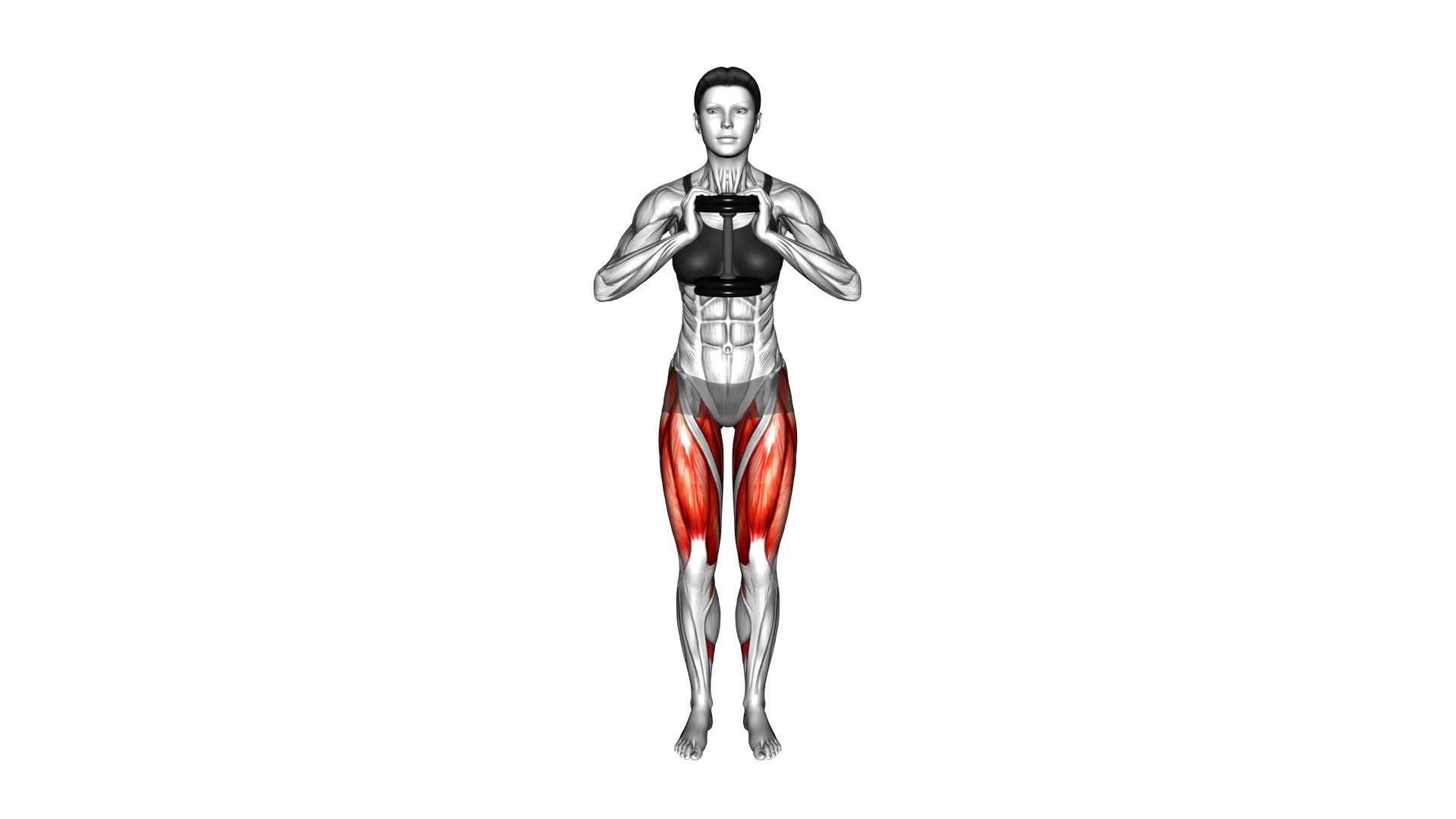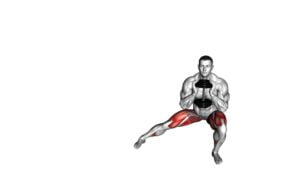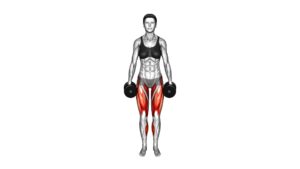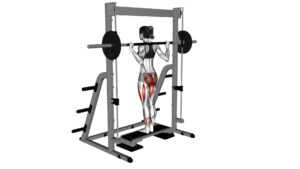Dumbbell Side Lunge (VERSION 3) (female) – Video Exercise Guide & Tips

Are you looking for a challenging lower body exercise that targets multiple muscle groups? Look no further!
Watch This Exercise Video
In this video exercise guide, we'll show you how to do the Dumbbell Side Lunge (Version 3) specifically designed for females.
This exercise not only helps strengthen your legs and glutes, but also improves your balance and stability.
Follow along with our step-by-step instructions and tips to maximize your results and avoid common mistakes.
Let's get started!
Key Takeaways
- Dumbbell side lunges target multiple muscle groups in the lower body
- They strengthen the legs and glutes
- They improve balance and stability
- Using dumbbells increases muscle activation and provides cardiovascular benefits
Benefits of Dumbbell Side Lunge
Experience the numerous benefits of the dumbbell side lunge. This exercise not only helps to activate multiple muscles in your lower body but also provides cardiovascular benefits.
When performing the dumbbell side lunge, you engage muscles such as the quadriceps, hamstrings, glutes, and adductors. These muscles work together to stabilize your body and propel you back up from the side lunge position. By incorporating dumbbells into the exercise, you add an extra challenge and increase the muscle activation.
In addition to its muscle activation benefits, the dumbbell side lunge also offers cardiovascular benefits. This exercise gets your heart rate up, making it an effective way to improve your cardiovascular fitness. The movement involves stepping out to the side and lowering your body into a lunge position, then returning to the starting position. This repetitive motion helps to elevate your heart rate and improve your overall endurance.
By regularly incorporating the dumbbell side lunge into your workout routine, you can strengthen and tone your lower body muscles while also improving your cardiovascular fitness. It's a versatile exercise that can be modified to suit different fitness levels and goals.
Proper Form and Technique
To ensure proper form and technique for the dumbbell side lunge, follow these guidelines.
One common misconception is that you need to take a wide step to the side. However, this can put unnecessary strain on your knees and hips. Instead, start with a shoulder-width stance and take a moderate step to the side. Keep your back straight and chest up throughout the movement to maintain proper posture.
Another common mistake isn't bending the knee enough during the lunge. Make sure to bend your knee at a 90-degree angle, keeping it in line with your toes. This will engage your glutes and hamstrings properly.
For beginners, modifications can be made to make the exercise more accessible. You can start by performing the side lunge without any weights, focusing on mastering the movement pattern first. As you gain strength and confidence, you can gradually add dumbbells. Additionally, if you have difficulty balancing, you can use a chair or wall for support. This will help you maintain stability while performing the exercise.
Now that you understand the proper form and technique, let's move on to the next section about variations and progressions.
Variation and Progressions
Now let's explore some variations and progressions for the dumbbell side lunge to challenge and improve your exercise routine.
If you're looking to take your side lunges to the next level, there are a few advanced modifications you can try. One option is to increase the weight of the dumbbells you're using. This won't only challenge your muscles more, but also improve your overall strength.
You can also try incorporating a jump into the side lunge, which will add an explosive element to the exercise and increase your heart rate.
Another variation to consider is the lateral lunge to balance. Instead of returning to the starting position after each side lunge, you can perform a lateral lunge on one side and then transition directly into a single-leg balance. This won't only target your leg muscles, but also improve your balance and stability.
In terms of muscle activation, it's important to focus on engaging your glutes, quads, and hamstrings throughout the movement. To do this, make sure you push through your heels as you come back up from the lunge and really squeeze your glutes at the top. This will help maximize the benefits of the exercise and ensure that you're targeting the right muscles.
Common Mistakes to Avoid
To avoid common mistakes while performing the dumbbell side lunge, focus on maintaining proper form and alignment throughout the exercise. Here are some common mistakes to be aware of and modifications or regressions you can make to ensure you're performing the exercise correctly:
- Shallow lunge: One common mistake isn't lunging deep enough. To fix this, make sure to take a big step to the side and lower your body until your thigh is parallel to the ground. This will engage the muscles properly and maximize the benefits of the exercise.
- Uneven weight distribution: Another mistake is putting too much weight on one leg while lunging. This can lead to imbalances and potential injuries. To avoid this, focus on distributing your weight evenly between both legs throughout the movement.
- Rounded back: It's crucial to maintain a neutral spine throughout the exercise. Avoid rounding your back as this can strain your lower back. Instead, keep your chest lifted, shoulders back, and engage your core to support your spine.
Tips for Maximizing Results
To maximize your results with the dumbbell side lunge, incorporate these tips into your workout routine.
- Focus on maximizing intensity during your workouts. This means pushing yourself to your limits and constantly challenging your muscles. One way to do this is by increasing the weight of the dumbbells you use. As you become stronger, gradually increase the weight to keep your muscles working hard.
- Incorporate equipment such as resistance bands or ankle weights. These tools can add an extra level of difficulty to your side lunges, helping to further engage your muscles and increase the intensity of your workout.
Proper form is essential when performing the dumbbell side lunge.
- Keep your back straight, chest up, and core engaged. Step to the side with one foot, bending at the knee and hip while keeping the other leg straight. Push through your heel to return to the starting position. Remember to breathe throughout the movement.
Consistency is key for seeing significant results.
- Incorporate the dumbbell side lunge into your workout routine at least two to three times a week. Gradually increase the number of repetitions and sets as you progress.
Frequently Asked Questions
How Many Sets and Repetitions Should I Do for the Dumbbell Side Lunge Exercise?
When it comes to the dumbbell side lunge exercise, determining the number of sets and repetitions depends on your fitness level and goals. Generally, it's recommended to start with 2-3 sets of 10-12 repetitions on each leg.
This exercise targets your lower body, specifically your glutes, hamstrings, and quads. It also helps improve balance and stability.
Remember to use proper form and gradually increase the intensity as you get stronger.
Can I Perform the Dumbbell Side Lunge Exercise if I Have Knee or Hip Pain?
Can I modify the dumbbell side lunge exercise for knee or hip pain?
Absolutely! If you're experiencing discomfort in your knees or hips, it's important to listen to your body and make modifications. You can try reducing the range of motion, using lighter weights, or even performing a different exercise altogether that doesn't aggravate your pain. Always consult with a healthcare professional for personalized advice.
What're the benefits of the dumbbell side lunge exercise for overall leg strength?
Let's explore that next.
Should I Use Lighter or Heavier Dumbbells for the Dumbbell Side Lunge Exercise?
When it comes to the dumbbell side lunge exercise, you might be wondering whether to use lighter or heavier dumbbells.
Well, using heavier dumbbells can increase the challenge and help build strength in your legs and glutes.
On the other hand, using lighter dumbbells can be beneficial if you're focusing on improving your form or if you're a beginner.
Ultimately, the choice depends on your fitness level and goals.
Can I Incorporate the Dumbbell Side Lunge Exercise Into My Leg Day Routine?
Yes, you can definitely incorporate the dumbbell side lunge exercise into your leg day routine.
It's a great exercise that targets your glutes, quads, and hamstrings, helping to strengthen and tone your lower body.
By adding dumbbells to the side lunge, you increase the resistance and challenge your muscles even more.
This can lead to greater muscle growth and improved overall leg strength.
Are There Any Modifications or Alternatives to the Dumbbell Side Lunge Exercise for Beginners?
Looking for alternatives or modifications to the dumbbell side lunge exercise?
If you're a beginner, there are a few options you can try. Instead of using dumbbells, you can start with bodyweight lunges to build strength and stability.
Another modification is to perform the side lunge with a shorter range of motion, so you don't have to go as low.
Remember to focus on proper form and gradually increase intensity as you progress.
Conclusion
In conclusion, the dumbbell side lunge is an effective exercise for targeting the muscles in your legs, particularly your glutes, quads, and hamstrings. By incorporating dumbbells into the exercise, you can increase the intensity and challenge your muscles even more.
Remember to maintain proper form and technique throughout the exercise to avoid any injuries. Don't be afraid to try different variations and progressions to keep challenging yourself and maximizing your results.
Keep pushing yourself and enjoy the benefits of this great exercise!

Author
Years ago, the spark of my life’s passion ignited in my mind the moment I stepped into the local gym for the first time. The inaugural bead of perspiration, the initial endeavor, the very first surge of endorphins, and a sense of pride that washed over me post-workout marked the beginning of my deep-seated interest in strength sports, fitness, and sports nutrition. This very curiosity blossomed rapidly into a profound fascination, propelling me to earn a Master’s degree in Physical Education from the Academy of Physical Education in Krakow, followed by a Sports Manager diploma from the Jagiellonian University. My journey of growth led me to gain more specialized qualifications, such as being a certified personal trainer with a focus on sports dietetics, a lifeguard, and an instructor for wellness and corrective gymnastics. Theoretical knowledge paired seamlessly with practical experience, reinforcing my belief that the transformation of individuals under my guidance was also a reflection of my personal growth. This belief holds true even today. Each day, I strive to push the boundaries and explore new realms. These realms gently elevate me to greater heights. The unique combination of passion for my field and the continuous quest for growth fuels my drive to break new ground.







